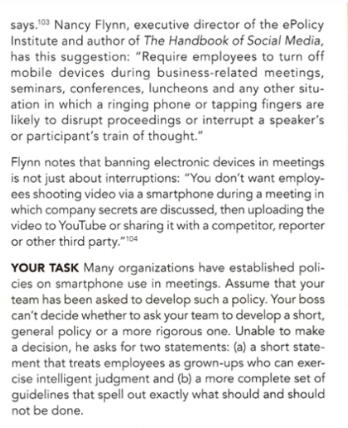Answered step by step
Verified Expert Solution
Question
1 Approved Answer
Typical smartphone users whip out their devices to check them about 80 times a day, according to Apple. Out of boredom or to catch


Typical smartphone users whip out their devices to check them about 80 times a day, according to Apple. Out of boredom or to catch up, some businesspeople com- pulsively eyeball their smartphones and tablets to read e-mail, search the Internet, and check Facebook, Insta- gram, or Twitter even during meetings. However, many professionals are growing tired of disruptions caused by electronic gadgets during meetings. Fortunately, nine in ten people oppose using smart devices during meetings, movies, church services, or other places where attentive- ness is expected.102 Etiquette consultants concur: "Electronic devices are like the smoking of the '90s," says Pamela Eyring, president of the Protocol School of Washington. "Companies are aggravated and losing productivity." Businesses hire her to enact formal policies and to teach workers "why it's not a good idea to be texting while your boss is speaking at the podium," Eyring says.103 Nancy Flynn, executive director of the ePolicy Institute and author of The Handbook of Social Media, has this suggestion: "Require employees to turn off mobile devices during business-related meetings, seminars, conferences, luncheons and any other situ- ation in which a ringing phone or tapping fingers are likely to disrupt proceedings or interrupt a speaker's or participant's train of thought." Flynn notes that banning electronic devices in meetings is not just about interruptions: "You don't want employ- ees shooting video via a smartphone during a meeting in which company secrets are discussed, then uploading the video to YouTube or sharing it with a competitor, reporter or other third party."10 YOUR TASK Many organizations have established poli- cies on smartphone use in meetings. Assume that your team has been asked to develop such a policy. Your boss can't decide whether to ask your team to develop a short, general policy or a more rigorous one. Unable to make a decision, he asks for two statements: (a) a short state- ment that treats employees as grown-ups who can exer- cise intelligent judgment and (b) a more complete set of guidelines that spell out exactly what should and should not be done.
Step by Step Solution
★★★★★
3.39 Rating (146 Votes )
There are 3 Steps involved in it
Step: 1
here are the two statements your team could provide a Short Statement We trust our employees to use ...
Get Instant Access to Expert-Tailored Solutions
See step-by-step solutions with expert insights and AI powered tools for academic success
Step: 2

Step: 3

Ace Your Homework with AI
Get the answers you need in no time with our AI-driven, step-by-step assistance
Get Started


